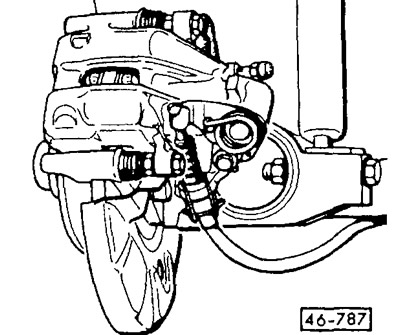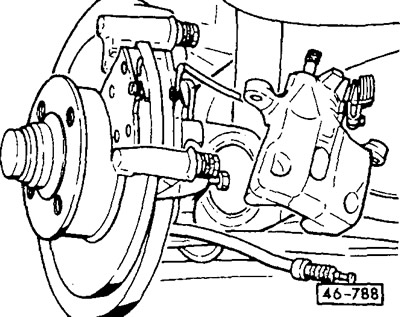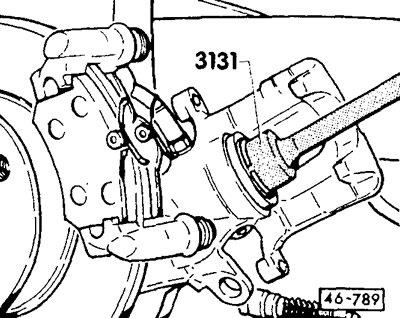Removing
Loosen the wheel bolts, lift the car from behind, remove the wheels.
Attention: If the brake linings are to be reinstalled, their location must be marked before removal. It is not allowed to change the pads in places, for example, change the outer one from the inner one or rearrange from the right wheel to the left and vice versa. Changing the location of the pads can lead to uneven braking action. It is recommended to use only original VW/AUDI brake pads. The rear brake pads must only be replaced as a set, even if only one pad has reached the wear limit.

Remove the handbrake cable from the caliper.

Remove the 2 caliper mounting bolts while holding the guide pins. Remove the caliper and hang it on a wire to the body so as not to squeeze the brake hose. Do not unscrew the brake hose, otherwise it will be necessary to remove air from the brake system.
Pull out the brake pads.
Installation
Caution: Do not depress the brake pedal when the brake pads are removed, otherwise the piston will be pushed out of the caliper housing.
Clean the guide surfaces or pads in the pads with a suitable soft metal brush or wipe with a cloth soaked in alcohol. Do not use solutions containing mineral oils or sharp-edged tools,
Before installing the pads, examine the brake discs by touch with your fingers for the absence of recesses. Notched discs can be turned (workshop work), depending on whether they have sufficient thickness. Always grind discs on both sides and pay attention to whether there is sufficient reserve «for wear remains after turning.
Measure the thickness of the brake discs, see below.
Check dust caps for cracks. Replace damaged caps immediately, as penetrating dirt will quickly break the tightness of the caliper. In this case, the caliper must be removed and disassembled (workshop work).

By turning the piston to the right, using a special key VW-3131, screw it in under strong pressure. If a special tool is not available, insert an iron plate into both of its grooves to screw in the piston.
Attention: The piston must not be pressed in with a return tool, otherwise the automatic adjustment in the caliper will be impaired.
Attention: When the piston is pressed into the cylinder, the brake fluid is squeezed out of the brake cylinder into the expansion tank. Monitor the fluid level in the tank and, if necessary, suck out excess fluid with a siphon.
For suction, use a bottle that was used to remove air from the hydraulic system, or a plastic bottle that previously only came into contact with brake fluid. Do not use bottles intended for drinking liquids! Brake fluid is poisonous and must never be sucked out by mouth through a hose. After replacing the brake linings, the level of brake fluid in the compensation tank must also not exceed the mark «MAX», because the liquid expands when heated. The brake fluid flowing out of the reservoir gets under the main brake cylinder, destroys the varnish coating and leads to corrosion.
Insert both brake pads» brake shield. When doing this, make sure that both pressure springs are evenly positioned upwards and parallel to the upper edge of the trims.
Insert the caliper and fasten it to the brake shield with new self-locking bolts to a torque of 35 Nm while holding the guide pins.
Note: Each VW/AUDI Brake Lining Repair Kit comes with 2 new self-locking bolts for each caliper. These bolts must be used every time.
After each replacement of the brake linings, carry out a basic adjustment of the rear wheel disc brake.
Connect the handbrake cable to the caliper housing.
Screw on the wheel. Lower vehicle and tighten wheel bolts crosswise to 110 Nm.
Check the level of brake fluid in the expansion tank and, if necessary, top up the tank to the mark «MAX».
Caution: Depress the brake pedal strongly repeatedly until strong resistance is felt. In this way, the brake linings are centered and positioned appropriately for the operating conditions.

Visitor comments